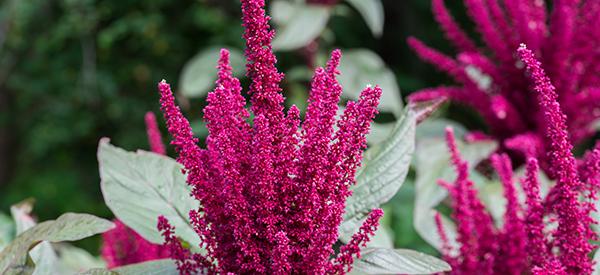
Amaranth
Amaranth (Amaranthus sp.), known by many as pigweed, is an abundant garden weed. This common plant is a North American native that is not only edible but also holds a host of potential health benefits.
As food sovereignty evolves from general awareness to a leading priority, amaranth is a plant worth knowing and knowing well. Amaranth produces a highly nutritional pseudocereal or seed that contains impressive medicinal benefits while being rich in protein, vitamins, and minerals. As a food source, amaranth helped to give rise to many ancient Mesoamerican civilizations including the Aztecs, Mayans, and Incans.
Of the 75 or so amaranth species, some are notably grown for their seed, others for their especially tasty leaves, and others are grown for their ornamental value. Most amaranth species are edible. Amaranth species readily cross-pollinate, so keeping track of individual varieties can become complicated. Some amaranth species grown specifically for their seed production are red amaranth (A. cruentus), and (A. hypochondriacus), while (A. tricolor) is more often grown for its flavorful leaves.
Leaves are known to have a sweet, spinach-like flavor and are used fresh in salads. Older leaves of some species make a nice cooked green as well. The seeds are tiny, like poppy seeds, and smaller than quinoa. Amaranth seeds can be used the same way, in baked goods, grain bowls, pilafs, breakfast cereals, and smoothies.
Where Amaranth is Found
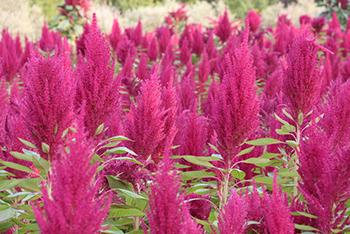 Amaranth is a common garden weed that is becoming more and more popular in alternative agriculture. Weedy species prefer the disturbed ground and are often spotted in the degraded prairie, fallow fields, sunny spots along roads, and waste areas.
Amaranth is a common garden weed that is becoming more and more popular in alternative agriculture. Weedy species prefer the disturbed ground and are often spotted in the degraded prairie, fallow fields, sunny spots along roads, and waste areas.
Native to the Americas, amaranth is cultivated throughout North, South, and Central America. Interestingly, the largest amaranth producer is China, and the largest importer of amaranth grain is the USA.
This possibly underutilized pseudocereal may be an important food of the future. Its success in the past, its incredible adaptability, partnered with its impressive nutrition profile, and high yields make amaranth a significant plant to know and grow.
Related: The Complete Map of Edible Plants: Find Out What You Have in Your Area! (Video)
How to Identify Amaranth
- Shape: Summer annual 1 to 8 feet tall that may be upright or pendulous with a stout central stem.
- Leaves: Alternate leaves are oval with pointed tips, average 6 inches long and 4 inches wide.
- Flower: Upright or pendulous flower spikes in pink, burgundy, orange, red, or green.
- Stem: Thick, round, hollow stems.
- Fruit & Seeds: Seeds are tiny grains that may be black, brown, red, yellow, or white.
Related: Plant Identification Guide – 400 Wild Plants That You Can Forage For (Video)
How to Grow Amaranth
Amaranth tolerates many conditions but prefers full sun, average to poor soil, and average moisture. They can handle dry heat better than most leafy greens. Most species grow in zones 2 to 11. Interestingly, amaranth seeds can stay viable in the soil for over 30 years.
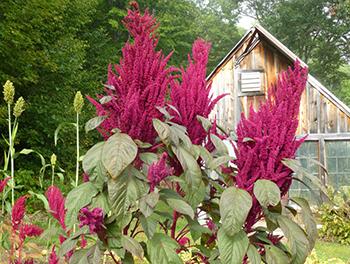 Amaranth’s abundant seed can joyfully sprout throughout the garden, yard, and field. Seeds germinate within 7 to 14 days, after the last frost date. Once identified, amaranth volunteers can be thinned or transplanted to their preferred location. As their flowers dry, the seed will easily drop from the plants. It may be best to let amaranth seedlings grow in an area suitable for future generations. If many amaranth species grow nearby, seedlings may not grow true to the parent plant.
Amaranth’s abundant seed can joyfully sprout throughout the garden, yard, and field. Seeds germinate within 7 to 14 days, after the last frost date. Once identified, amaranth volunteers can be thinned or transplanted to their preferred location. As their flowers dry, the seed will easily drop from the plants. It may be best to let amaranth seedlings grow in an area suitable for future generations. If many amaranth species grow nearby, seedlings may not grow true to the parent plant.
Related: 10 Plants That You Should Never Plant Together (Video)
How to Harvest Amaranth
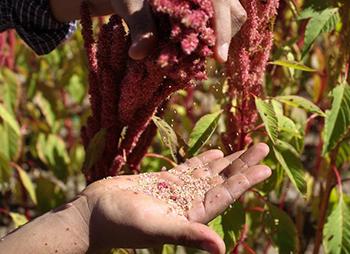 Amaranth greens can be harvested throughout the growing season. Luckily, they don’t turn bitter with age. Instead, their flavor is fuller with age. Keep in mind though, younger amaranth leaves are more tender.
Amaranth greens can be harvested throughout the growing season. Luckily, they don’t turn bitter with age. Instead, their flavor is fuller with age. Keep in mind though, younger amaranth leaves are more tender.
Harvesting the abundant amaranth seed is rewarding. As the flower heads begin to dry, trim the heads off and place them in bags. Let the seed ripen for a few days or weeks. Shake the seed heads into the bags or take the dried flowerheads and tickle the seeds out over a large bowl. Then, the seed needs to be cleaned from the chaff. Luckily, the seed is heavier than the chaff. This process is explored further below.
What Amaranth Is Good For & The Natural Remedies Made From It
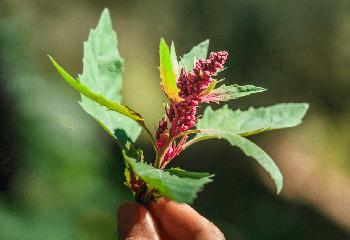 Amaranth is an excellent food source full of important micronutrients. It has more protein than many cereal crops at 9.3 g per 1 cup of cooked amaranth. The seeds are also high in manganese, magnesium, phosphorus, and iron.
Amaranth is an excellent food source full of important micronutrients. It has more protein than many cereal crops at 9.3 g per 1 cup of cooked amaranth. The seeds are also high in manganese, magnesium, phosphorus, and iron.
This ancient grain, with its many health benefits, is increasingly more available through health food and grocery stores. It is wonderfully versatile. The enjoyable nutty flavor is perfect for adding to cereals, grain pilafs, granola, or using as a salad topper.
Related: How to Make Amaranth Pilaf (Video)
What Parts of Amaranth Are Used In Remedies?
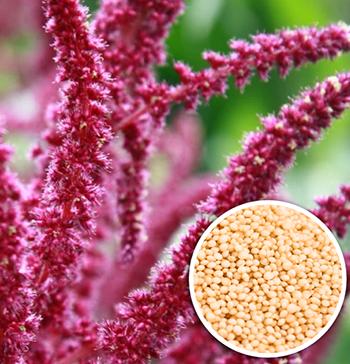 The phytochemical composition of amaranth seeds shows many potential health benefits. This is due to research strongly suggesting antioxidant and anti-inflammatory activity.
The phytochemical composition of amaranth seeds shows many potential health benefits. This is due to research strongly suggesting antioxidant and anti-inflammatory activity.
Amaranth seeds not only contain many vitamins, minerals, fiber, and protein, they also have macronutrients and micronutrients such as fatty acids, tocopherols, and carotenoids.
Research has shown amaranth in the diet provides medicinal benefits. These include lowering cholesterol levels, stimulating the immune system, and lowering the risk of oxidative stress. They each have positive effects on obesity, cancer, cardiovascular disease, and diabetes.
Amaranth Seed Harvest
In the harvesting below, I used a black seeded variety common in my garden. (Amaranthus retroflexus)
Method
Step 1: Collect amaranth flowerheads in the fall. They will be dry and brown. This one is quite prickly, so wearing gloves may help. I snipped off the seed heads and placed them upside down in paper bags. They were tucked out of the way until other more pressing fall chores were done.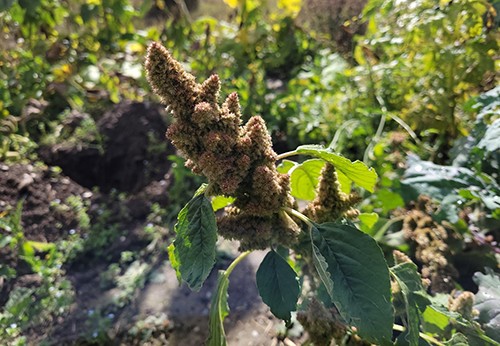
Step 2: In the quieter times of early winter, I pulled the bags out and started winnowing the seed from the flowerheads. In their dryness, the flowerheads were even less friendly and sharper, so gloves were necessary for me. In a large bowl, I roughly winnowed the seed. You can see the seed amongst the dried plant debris.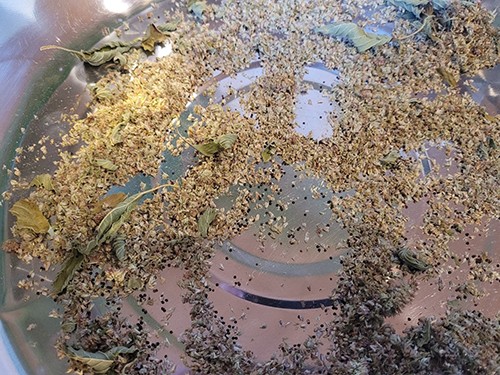
Step 3: Shake the seed to the bottom, the light plant material is easy to skim off the top.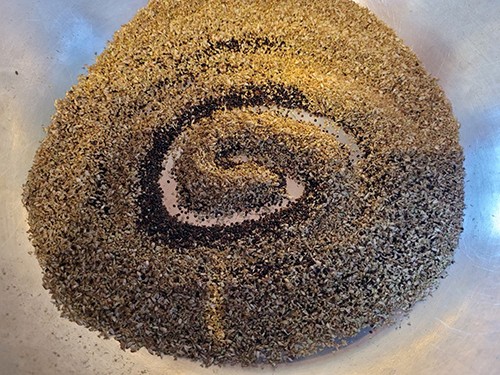
Step 4: This colander has the perfect-sized holes for amaranth seeds. Either a tedious or meditative task, I slowly brushed the seed through the colander.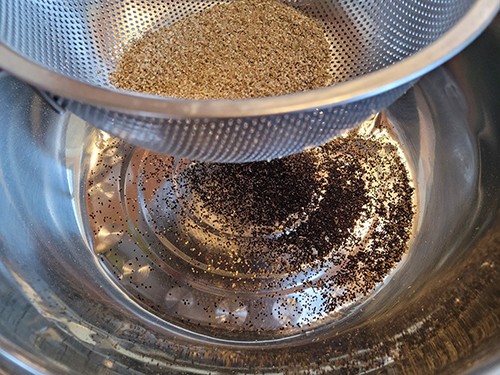
Step 5: To further remove the chaff from the seed, I brought the bowls outside and tossed the seed back and forth from bowl to bowl in a light breeze. The breeze helped blow away lots of chaff. Seed likely blew away as well, so I did this task over an area where amaranth is welcomed to grow over the coming years.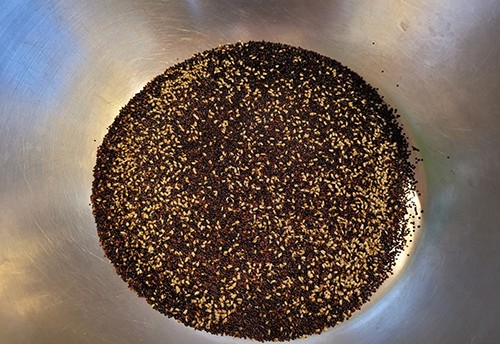
Step 6: As you can see, the seed is not perfectly clean. It was used in sprouting experiments, so I wasn’t overly concerned. If I wanted to eat this in other ways mentioned below, I would process it a little more making it as clean as possible.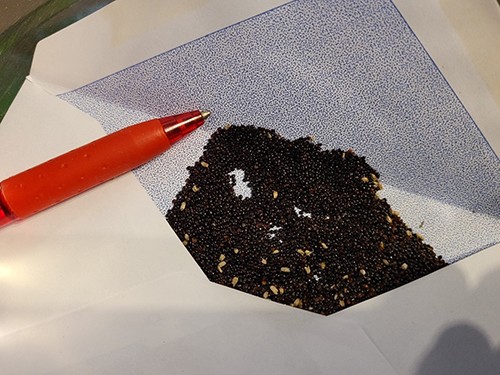
Potential Uses
Amaranth is simple to enjoy. It has a nutty flavor. The seeds are very small and can be used the same way you might include flax seeds, poppy seeds, sesame seeds, or chia seeds in your diet. They work well added to baked goods, salads, or smoothies.
Amaranth is perfect added to grain bowls, sweet like oatmeal, or savory like a pilaf. Amaranth also pops. I like to toast certain seeds and grains, such as quinoa, before cooking to improve their flavor. Amaranth can be toasted in this way before adding water. Consider toasting with finely chopped onion, garlic, ginger, or spices to infuse flavor into the nutritious ancient grain. The water to amaranth ratio is 1 ½ cup water to ½ cup amaranth.
In some microgreen and seed sprouting experiments, I did try sprouting and growing amaranth microgreens.
Growing Amaranth Microgreens Guide:
- To successfully grow amaranth microgreens you need to have a deep medium, about 3-4 inches. This will give your roots room to grow and the soil will stay moist enough.
 It’s a good idea to use a seed shaker for your seeds but you can do it by hand if you prefer. You’ll need to lightly cover the top of your growing medium.
It’s a good idea to use a seed shaker for your seeds but you can do it by hand if you prefer. You’ll need to lightly cover the top of your growing medium.- Once you’ve planted the seeds slightly mist them with water.
- You should then cover the tray with another tray
- For the next 2-3 days lightly mist the seeds once a day; you should see signs of germination by the end of this period.
- Once they have germinated you can leave the cover on for an extra 24 hours, this will help them grow a light pink color. However, as soon as they reach ½ inch tall it’s time to remove the cover and transfer them to the light.
Once they hit 10 days old they should be ready to harvest!
Related: Add This “Unusual Nutrient” to Coffee or Tea, to Effortlessly and Fully Empty Your Bowels Every Single Morning (Learn More)
Dosage
Amaranth can offer significant health benefits and enhanced nutrition to the diet. As with any new ingredient to your diet, start with a small amount to ensure no unwanted effects.
How To Preserve Amaranth
With an 8000-year tradition, amaranth is certainly worthy of preserving. Seeds have a very long shelf life. Through many civilizations, this powerful, healthful plant has been targeted with extinction in efforts to concur with traditional communities. And amaranth persists!
What are the best ways to preserve amaranth? Know it. Grow it. Harvest seeds in the autumn. Dry them with good air circulation in the dark. Collect them. Plant them. Share them. Oh, and eat them too!
Common Species of Amaranth
| Common and Scientific Name | Growth Habit | Inflorescence* | Geographic Range | Other Plant Characteristics |
|---|---|---|---|---|
| Redroot Pigweed Amaranthus retroflexus | Erect, branched, 2–7 ft | Stiff, branched terminal spikes, individual branches usually <2 in long, thicker than pencil | Throughout North America including Alaska | Upper stem and leaves usually covered with fine hairs; leaf blades large (6 in) on vigorous plants |
| Smooth Pigweed Amaranthus hybridus | Erect, branched, 2–7 ft | Soft, highly branched terminal spikes, individual branches thinner than pencil | Throughout North America | Similar to redroot but highly variable, many local variants, may hybridize with closely related species |
| Palmer Amaranth Amaranthus palmeri | Erect, branched, 2–10 ft | Long (to 18 in), simple or sparingly branched terminal spikes; male soft, female bristly | Southern half of U.S., Great Plains, Mexico | Extremely rapid, aggressive growth in hot climates, male and female flowers on separate plants; plants smooth and hairless |
| Powell Amaranth Amaranthus powellii | Erect, branched, 2–6 ft | Stiff, branched terminal spikes, branches 4–8 in long, thicker than pencil, held close to main axis | Throughout North America | First true leaves narrower and more tapered toward tip than redroot or smooth; plant may be smooth or hairy |
| Spiny Amaranth Amaranthus spinosus | Erect to bushy 1–4 ft | Slender, branched terminal spikes mostly male flowers; axillary clusters mostly female | Throughout North America, but mostly Southeastern U.S. | Pair of stiff, sharp ½-in spines at base of each leaf; stems smooth, hairless, often red |
| Waterhemp Amaranthus rudis or A. tuberculatus | Erect, tall 3–10 ft | Slender, simple or branched terminal spikes | Throughout U.S. and southern Canada except driest areas | Male and female flowers on separate plants; stems and leaves smooth and hairless; leaves often longer and narrower than other species |
| Prostrate Pigweed Amaranthus blitoides | Prostrate mat to 3 ft across | Small, dense clusters in leaf axils | Throughout U.S. and southern Canada | Leaves small (blade about 1 in) with distinct notch at tip; seeds dull black, larger than in other pigweeds (0.06 in) |
| Tumble Pigweed Amaranthus albus | Globular bush, 1–3 ft diameter | Small, dense clusters in leaf axils | Throughout North America | Mature plants break off at ground level, and are carried by wind, dispersing seeds; stems white to pale green, leaves light green |
Warnings And Cautions
There are no dietary concerns found as this food has been used by humans for millennia. Do always check with your healthcare provider before starting new diets or consuming large amounts of a new ingredient.
There isn’t enough reliable information to know if amaranth is safe to use as a medicine when pregnant or breastfeeding. Stay on the safe side and avoid use.
If wild harvesting amaranth, do take care that it is from a toxin- and pesticide-free area.
You may also like:
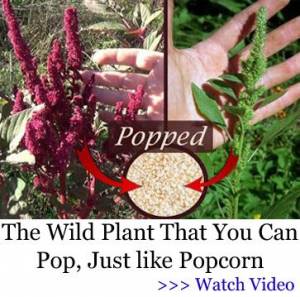 Homemade Anti-Inflammatory Golden Salve
Homemade Anti-Inflammatory Golden Salve
1 Cup Before Bed Shrinks Belly Fat All Night (Video)
What Happens If You Eat Chia Seeds Every Day?

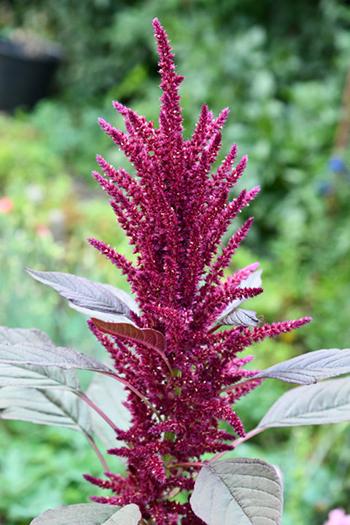
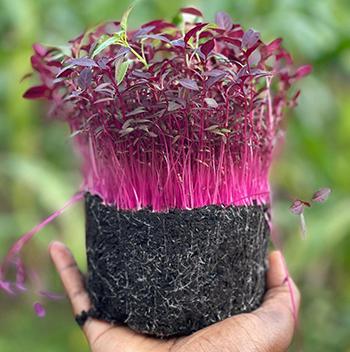
Get your gloves and Walgreens bags ready for the harvesting season.
Seed to plant (A. tricolor)
https://amzn.to/3M5YvNc
Seed to plant – Red Garnet
https://amzn.to/3M2jro8
Seed for healthy diet
https://amzn.to/3HfblVC
COOKING INSTRUCTIONS: Combine Amaranth and water in a nonstick saucepan with a tight-fitting lid. Bring to boil; cover, lower heat and let simmer for about 25 minutes. Use 2 1/2 – 3 cups liquid per cup of grain.
Also good for baking.
Thank you! This is a Wonderful article about an amazing plant!
And All the instructions we need! Thanks again…
A word of caution: about 6 years ago I found out I was celiac so I started a gluten free lifestyle. One day I tried a bowl of hot amaranth. I prepared it like oatmeal with some butter and sugar and ate it. I enjoyed it! Well about 45 minutes later I was in the shower and suddenly got very sick, like projectile uncontrollable vomiting. I don’t remember how long I threw up for, I just remembered waking up under a cold stream of water as I had passed out. I should have gone to the hospital! Anyway, I realized it was the amaranth I had had, it must have been. I looked it up and found that it was super rare to experience adverse effects, but just in case you are like me and react like I did, now you know. I’d advise starting with a very small dose, like a tablespoon full, wait an hour and go from there. Watch out for gluten free products which are now including amaranth more and more in a variety of items. I tried some of my boys GF cereal without reading the ingredients first and ended up calling in sick to work because I accidentally consumed amaranth. It was not as much as the first time I had it, so I was not on the verge of death, but I was vomiting again. If you aren’t allergic to it like me, then good for you! It is very versatile. If you are allergic to it, you might also be allergic to other ancient grains. Anyway, I love “The Lost Herbs”, I have learned so much! I just had to comment being that I’m probably the only person in this hemisphere who has had adverse effects from amaranth.
I was going to ask about being gluten free… That is VERY important information to include in articles that talk about foods that COULD possibly contain gluten. (grains!!)
Sorry about your horribly adverse reaction.
And YES! READ LABELS! Especially if you have ANY idea that you have or could have allergies.
Amaranth can be popped in a dry medium-high heated skillet, for about 30s when doing 1 Tbsp at a time. Then add to your cereal or other morning foods and enjoy! I do not know, however, whether the anti-nutrients are countered by just popping the seeds or whether they would need to be cooked. Anyone knows?
Nuts, seeds and grains need to be soaked then dried in order to remove harmful anti-nutrients.
I would buy the book but ClickBank is totally useless for credit card purchases. This ghost-grey lettering shows me someone needs to learn how to design websites.